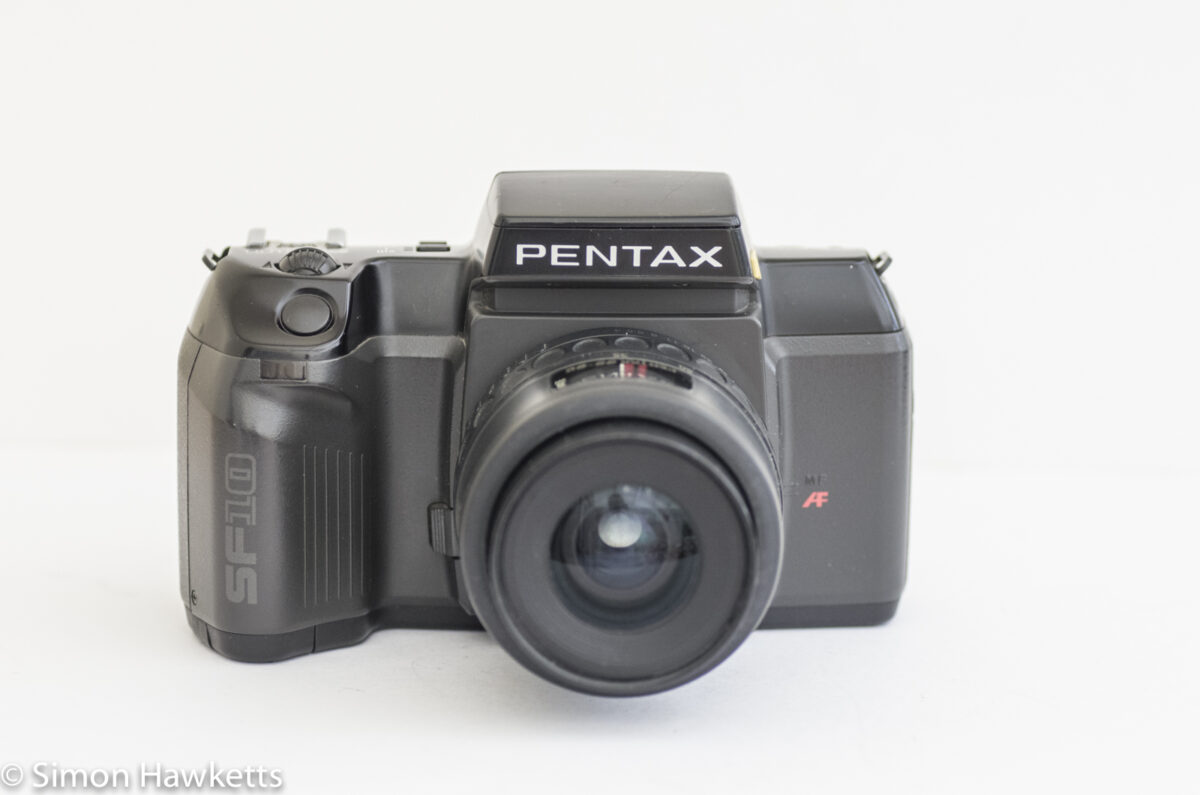The Pentax SF10 35 mm Autofocus SLR
This Pentax SLR comes from the SF range of cameras which Pentax introduced before the Z and MZ range, and were the first set of autofocus SLR cameras the company made. This model, the Pentax SF10, was also known as the Pentax SF7 and is similar in styling to the SFXn camera which I own, but is a rather simpler and more basic model than that. It was manufactured in about 1988.
Photos of the Pentax SF10
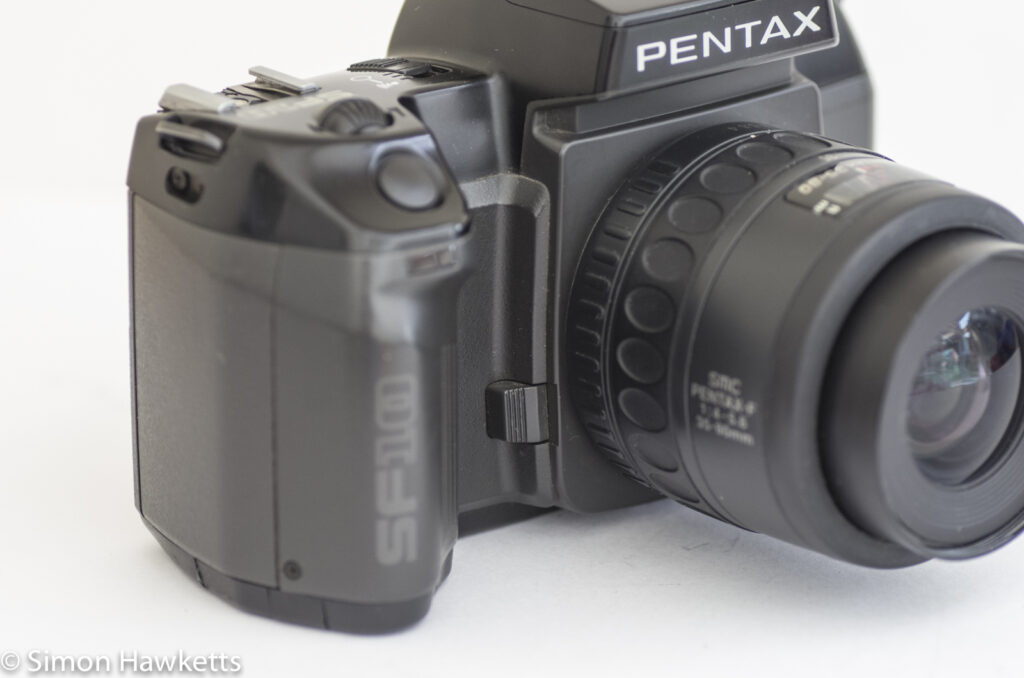
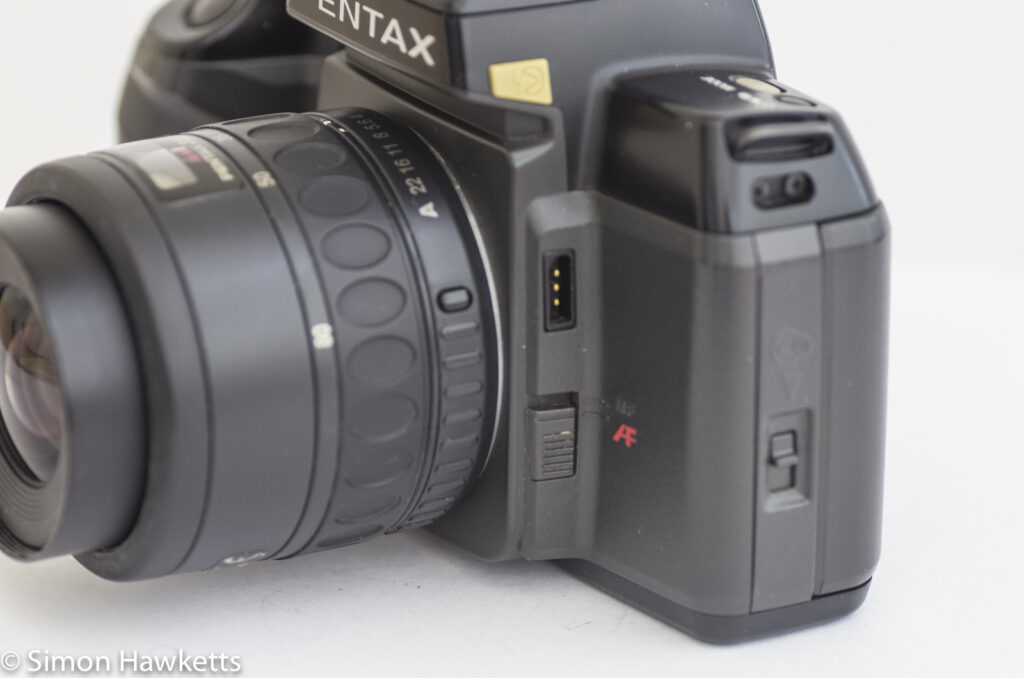
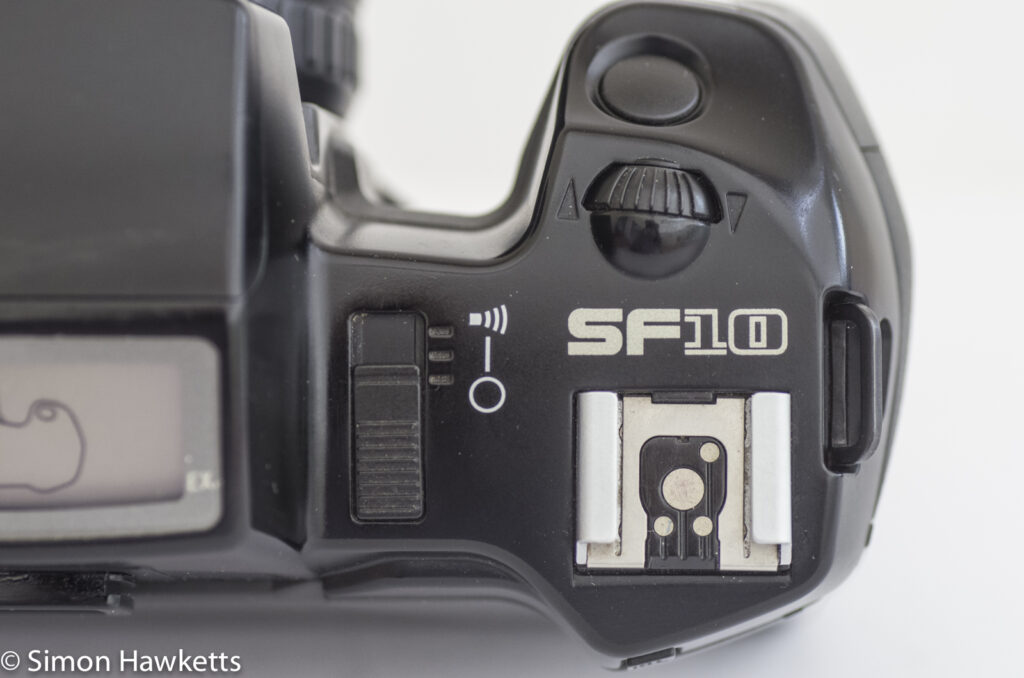

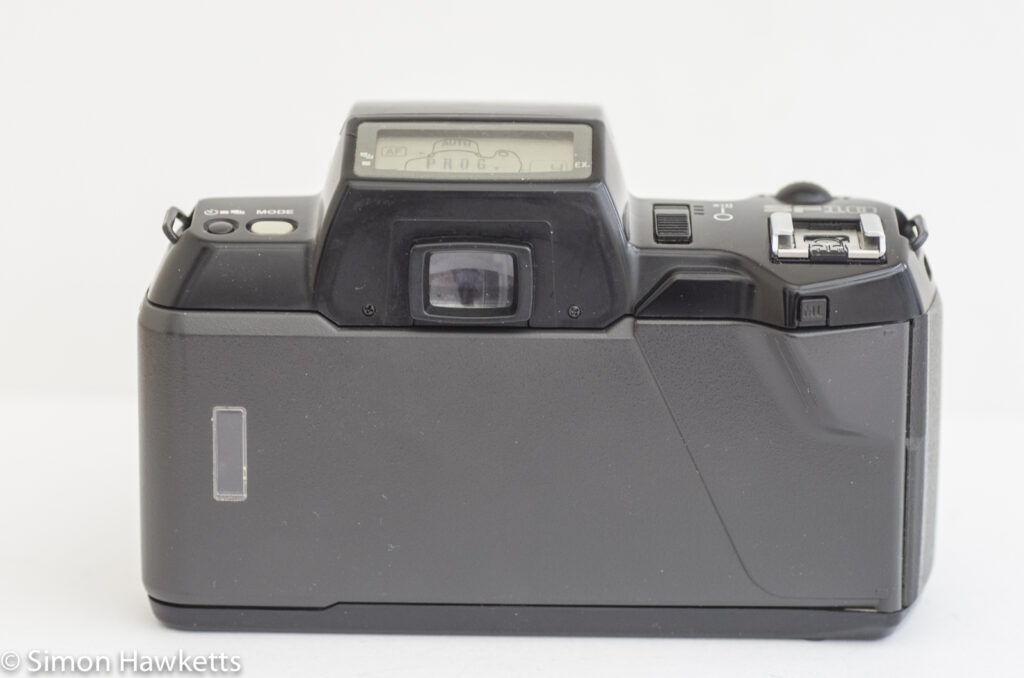
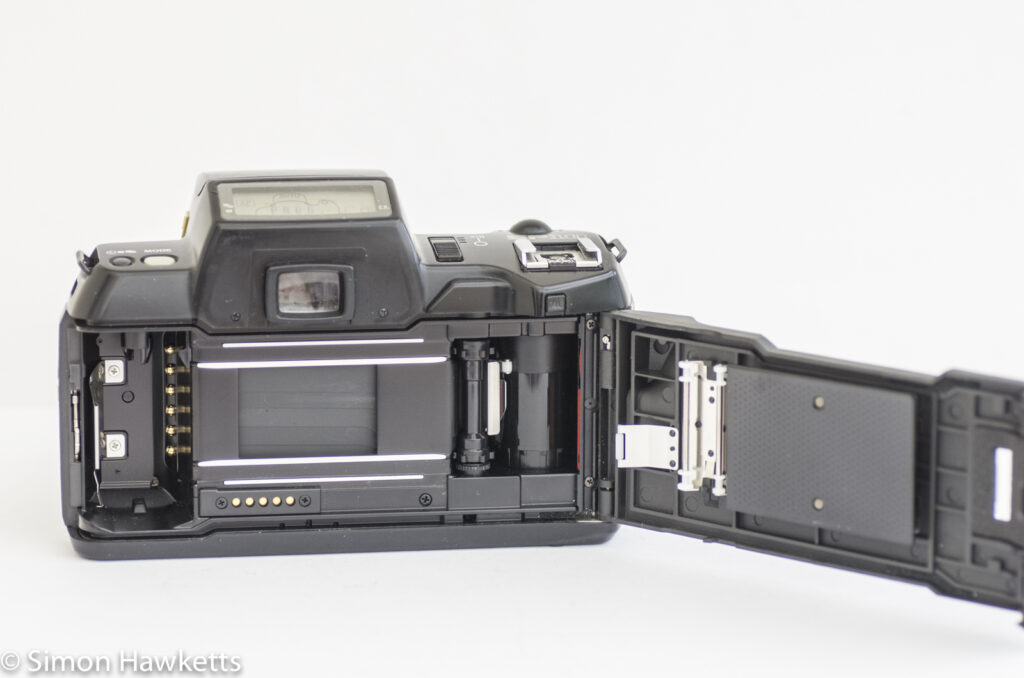

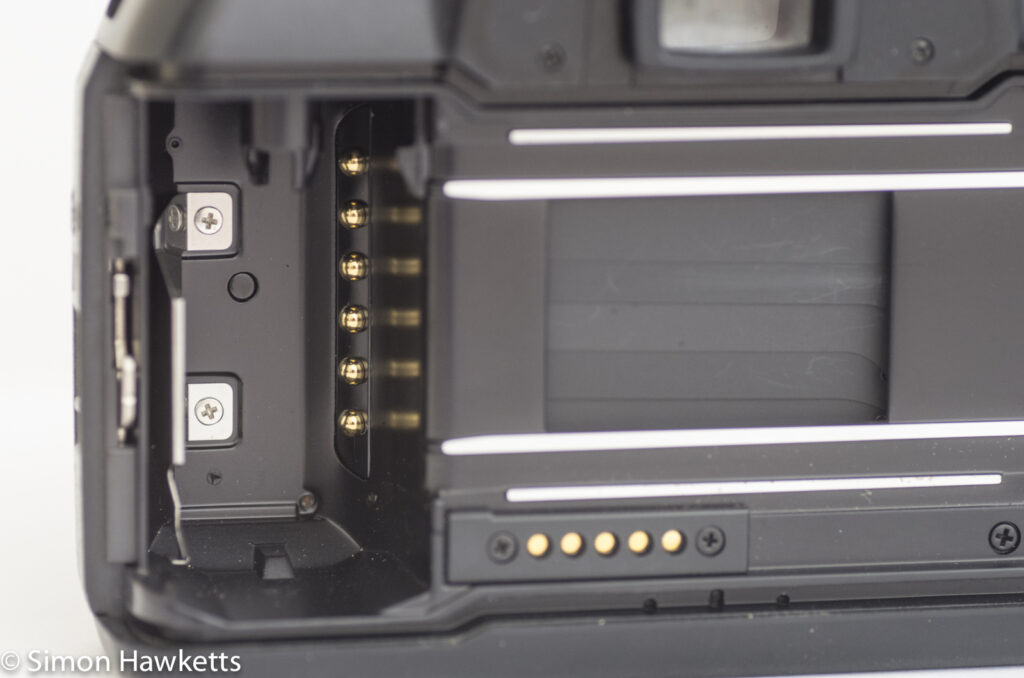
My Pentax SF10 Camera
I purchased this camera from eBay UK as a ‘sold as seen’ unit.
The previous owner said that it seemed to work when a battery was fitted, but that there were no guarantees that it would work properly. I quite like this sort of sale because I managed to get the camera for £2.99 with fairly certain knowledge that the camera would be fine because this series were so solid and reliable.
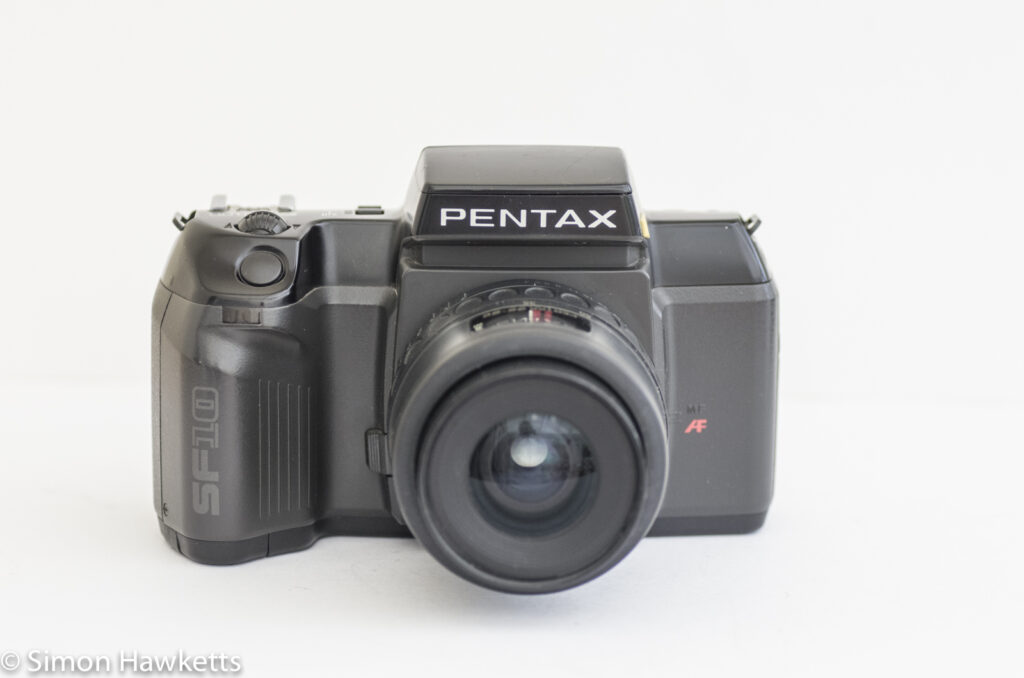
Sure enough, when the unit turned up I put a battery in it and fitted an SMC Pentax F 35-80 mm zoom, and it all seems to function properly. I selected each of the shutter speeds, and they all seem to be OK, and I would suspect that an electronically controlled shutter would either work correctly or not work – I wouldn’t expect the timings to go wrong. I also checked the focus worked and that the aperture stopped down as I changed the shutter speed in manual exposure mode, and everything looks fine.
Cosmetically, the camera has just a few marks on the top of the flash and also on the bodywork by the LCD. There is a bit of dirt in the film chamber door seal, which is not unexpected, and dirt and dust in many of the little cracks and crevices of the body. The eyepiece has disintegrated with age, which is a common failing on these cameras but to be honest that’s a pretty unimportant thing to deteriorate with age – it’s better than the MZ series which eventually all fail with shutter motor problems!
Pentax SF10 Description.
The Pentax SF10 is a sturdy and heavy camera, similar in weight and very slightly bigger than my digital Pentax K5 DSLR. Although heavy cameras are not a lot of fun to carry about, it is a good camera to get a hold of. The hand grip is quite deep and has a contoured feel which fits in the hand quite nicely. The shutter button falls nicely in place when the camera is in the hand, and it’s easy enough to alter shutter settings with the rocker switch placed behind the shutter button.
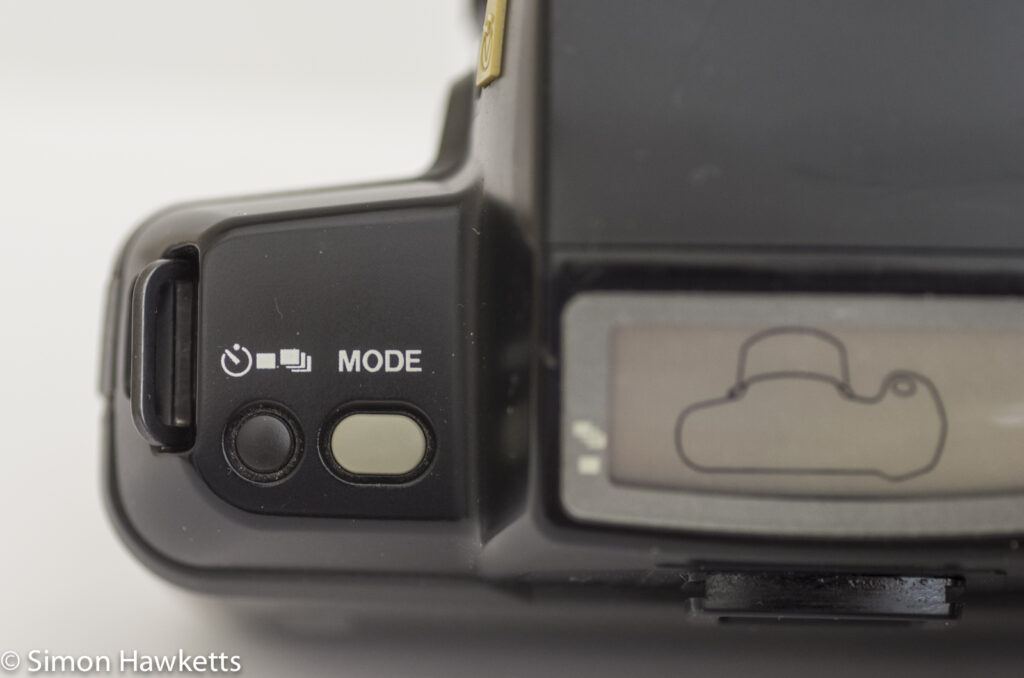
Changing modes however is a different matter. This camera was made at a time when electronics were being introduced into camera manufacture, and lots of cameras at this time had button press rather than rotary knobs to change settings, and I find they are not as easy or quick. On this camera the one saving grace is the way the camera modes are displayed; Instead of a small A, P, S etc displayed in a small LCD screen, the SF series had large LCD panels mounted on the top of the SLR prism. On the Pentax SF10, this LCD has a display which incorporated an outline shape of the camera which changes to show graphically the modes, and configuration changes.
The control buttons on the top panel of the camera are the mode button discussed above, a button to control the different drive modes, a rocker switch positioned behind the shutter release and the On/Off switch which has an optional ‘beep’ setting for audible feedback. On the back of the camera just behind the hot shoe is an exposure lock button and on the side of the lens mount is the Auto focus/Manual focus switch with an electronic cable release socket above.
The lens mount fitted to the SF10 is a full KAF mount, which means this camera can use any Pentax lens made up to the point the camera was made. It obviously wouldn’t be able to focus a modern ultrasonic motor lens, but any screw thread focused lens or manual K mount lens should be fine.
Exposure modes.
The Pentax SF10 camera offers all the normal exposure modes most photographers need and regularly use, but doesn’t feature the ‘scene’ modes which are popular these days. This, of course, is because it was made earlier than that sort of feature was introduced.
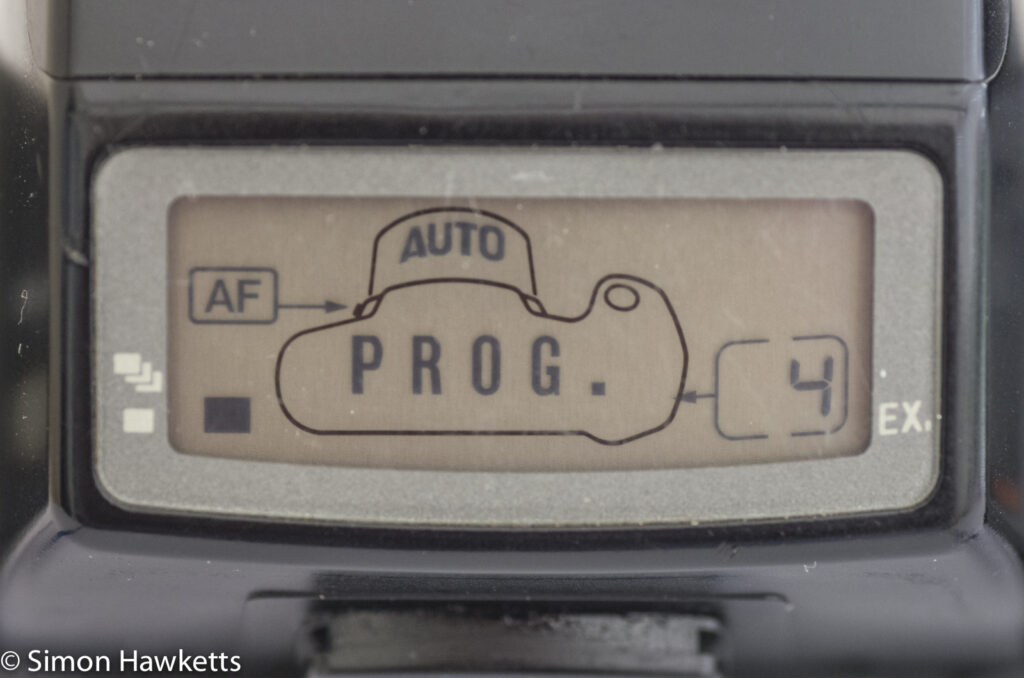
The exposure modes are selected with a combination of the mode button, the rocker switch and the aperture ring on the lens. If the lens aperture ring is set to ‘A’ the mode button and rocker switch will toggle between ‘PROG’ (program or fully automatic mode) and Shutter priority. These modes are shown on the top panel LCD as a series of updates to the picture of the camera – some examples can be seen in the pictures above.
Once the aperture ring is moved off the ‘A’ setting, the mode button and the rocker switch will toggle between AUTO (aperture priority), fully manual mode and bulb.
There is no option to provide any exposure compensation on this camera and since it’s also not possible to override the DX coding of the film speed that includes the trick of changing the film speed. There is an exposure memory lock button however, which can be used to meter a particular portion of a scene and then lock the exposure to that reading.
The metering in the camera is a 2 segment averaged reading with autofocus lenses, which changes to centre weighted with manual focus lenses.
Pentax SF10 Focus settings
As I said in the opening paragraph, this is one of the first autofocus cameras which Pentax made and employs a motor in the body of the camera which drives the focus ring via a screw thread coupling. This system has been maintained by Pentax up to the present day and my Pentax K5 can focus the lens fitted to the SF10 in exactly the same way (considerably faster of course and in lower light).
The autofocus performance of the Pentax SF10 is reasonable for the age of the camera. It wouldn’t win any speed battles today, but considering this is a 1st generation autofocus camera it’s reasonably fast in good light as long as the target area has some contrasting patterns.
When the light level drops, it does a bit of hunting about to find the correct position, but most of the time it will eventually get there. It’s not a quick or accurate as my SFXn, but then it was at the cheaper end of the SF series and the SFXn was at the top end. It is quite noisy during focusing – not just noise from the lens moving but from the focus motor itself which has a high-pitched whine. It reminds me of the Minolta 7000 which was also a 1st generation autofocus camera.
In common with all the early autofocus cameras I own, there is only one focus sensor fitted in the centre of the viewfinder. That may be considered a disadvantage, but in my experience I find one to be fine. I normally use the single central focus point anyway and use the ‘focus and re-compose’ option if I need to focus on something non-central. Obviously, modern cameras have many focus points in order to do focus tracking, but a camera of this age simply doesn’t have the speed to do that anyway.

For situations where there really isn’t enough light to successfully achieve focus lock, there is a small lamp built into the flash housing which is used to strobe the scene and get the lens to lock. I found on my copy of the camera this was not very successful, but again the light wasn’t very bright, so it may be just age which has caused it to dim. The camera won’t pop the flash up to use this light by itself, it needs to be raised by the photographer. Looking at the button which raises the flash, I would guess it’s a mechanical rather than electrical switch, so the camera couldn’t raise it anyway.
When focus is achieved there is a large indicator in the viewfinder which lights and an optional beep can sound as well, both of these also work when the camera is in manual focus mode either by switching the AF/MF switch or by fitting a manual focus lens. Although I like split image focusing screens for manual focus, the focus indicator is actually quite a useful device with manual lenses.
There is one other point I’d like to make about the autofocus on this camera. I have two Sigma autofocus lenses which this camera won’t focus. They are both screw driven autofocus lenses, which work without problem on my K5 and any of my MZ series cameras, but the screw drive doesn’t turn when they are fitted to the SF10. I checked that the screw drive is engaging with the camera body, and it is because turning the focus ring in autofocus mode results in the focus motor in the body turning (I wouldn’t recommend doing this, by the way). I wondered if it was something a bit odd with this particular camera, so I tried them both on my SFXn and found exactly the same thing. Just for information, the two lenses are a Sigma Zoom 28-80 mm f/3.5-5.6 and a Sigma Zoom 24-70 mm f/3.5-5.6 UC.
Pentax SF10 Viewfinder
The Pentax SF10 is equipped with a pentaprism viewfinder rather than the Penta Mirror finder used in the lower end MZ series cameras. This is welcome because it leads to a much brighter view, especially when used with a fast lens. Other than being a prism finder, the viewfinder is somewhat disappointing because there is no Depth of field preview available and also no diopter adjustment.
In terms of exposure and focus information visible in the viewfinder, the shutter speeds are visible on the right-hand side of the viewfinder and the letter ‘A’, ‘M’ or ‘P’ above to indicate the exposure mode. As mentioned above there is a focus indicator to show when focus is achieved and right at the bottom of the shutter speeds the letters LT indicate when a shutter speed longer than 1/30sec has been selected. All the shutter speeds below 1/60sec are in yellow indicating a tripod should be used – the rest are in green, although the 1/2000sec speed will flash if the exposure is over exposed when 1/2000 is selected.
Drive modes
The drive modes are set using the drive mode button and the rocker switch. The camera has a fairly simple selection of single shot, continuous shot and self-timer mode. The self-timer is electronic, with an LED on the front of the hand grip illuminated when the timer is running and the beep option counting the timer down. When the last couple of seconds are reached, the LED flashes in unison with the beep for a couple of seconds and then the shutter fires.
Overall assessment
This was an entry level camera when the SF series was introduced by Pentax, and as such it is missing some of the top end functions the SFXn camera had. However, most of the functions most photographers would use are here, with the exception of exposure compensation. Even that could be worked around by using the Exposure Lock button, so it’s more an inconvenience rather than a dealbreaker.
Many people may say the camera is too big and heavy, and you certainly know you are carrying it around, but it is pretty well-balanced and comfortable to use.
Pentax SF10 Specifications
- Pentax SF10 35 mm Autofocus SLR (also known as the Pentax SF7)
- 1st Generation autofocus camera
- Aperture priority, Shutter Priority, Program Mode & full Manual Mode
- 2 segment averaged metering with F series lenses, centre weighted with others
- KAF mount accepts all K mount lenses
- Solid, well built construction
- Single autofocus sensor centrally mounted.
- Pentaprism viewfinder
- Integrated RTF flash with autofocus assist light
- Shutter speed 30sec to 1/2000sec + Bulb
- Self timer with electronic countdown and visual indication
- Single shot and multiple shot mode
- Optional beep function for focus lock
- Focus confirmation light in the viewfinder
- Integrated off centre hot shoe
- Exposure lock
- DX coded film chamber
- Electronic cable release socket
- Powered by 2CR5 battery in grip
- Body Ser No: 4837188
- Manual available on-line here.
Questions frequently asked about the Pentax SF10 / SF7
When was the Pentax SF10 made?
The Pentax SF10 was introduced by Pentax in 1988.
What film type does the Pentax SF10 take?
The Pentax SF10 uses standard 35 mm film cassettes and automatically reads the film speed and loads/rewinds the film.
What battery does the Pentax SF10 take?
The Pentax SF10 is powered by a 2CR5 battery fitted in the hand grip.
What is my Pentax SF10 worth?
Depending on the condition and if it has a lens or not the SF10 is worth between about £20 and £50 when sold on eBay.
Discover more from Everything Vintage
Subscribe to get the latest posts sent to your email.

